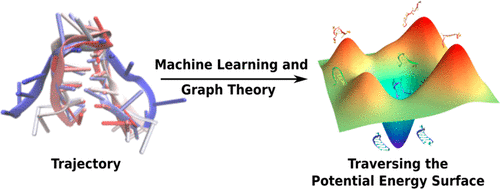当前位置:
X-MOL 学术
›
J. Chem. Theory Comput.
›
论文详情
Our official English website, www.x-mol.net, welcomes your
feedback! (Note: you will need to create a separate account there.)
A Probabilistic Framework for Constructing Temporal Relations in Replica Exchange Molecular Trajectories
Journal of Chemical Theory and Computation ( IF 5.7 ) Pub Date : 2018-05-23 00:00:00 , DOI: 10.1021/acs.jctc.7b01245 Aditya Chattopadhyay 1 , Min Zheng 2 , Mark P. Waller 3 , U. Deva Priyakumar 1
Journal of Chemical Theory and Computation ( IF 5.7 ) Pub Date : 2018-05-23 00:00:00 , DOI: 10.1021/acs.jctc.7b01245 Aditya Chattopadhyay 1 , Min Zheng 2 , Mark P. Waller 3 , U. Deva Priyakumar 1
Affiliation

|
Knowledge of the structure and dynamics of biomolecules is essential for elucidating the underlying mechanisms of biological processes. Given the stochastic nature of many biological processes, like protein unfolding, it is almost impossible that two independent simulations will generate the exact same sequence of events, which makes direct analysis of simulations difficult. Statistical models like Markov chains, transition networks, etc. help in shedding some light on the mechanistic nature of such processes by predicting long-time dynamics of these systems from short simulations. However, such methods fall short in analyzing trajectories with partial or no temporal information, for example, replica exchange molecular dynamics or Monte Carlo simulations. In this work, we propose a probabilistic algorithm, borrowing concepts from graph theory and machine learning, to extract reactive pathways from molecular trajectories in the absence of temporal data. A suitable vector representation was chosen to represent each frame in the macromolecular trajectory (as a series of interaction and conformational energies), and dimensionality reduction was performed using principal component analysis (PCA). The trajectory was then clustered using a density-based clustering algorithm, where each cluster represents a metastable state on the potential energy surface (PES) of the biomolecule under study. A graph was created with these clusters as nodes with the edges learned using an iterative expectation maximization algorithm. The most reactive path is conceived as the widest path along this graph. We have tested our method on RNA hairpin unfolding trajectory in aqueous urea solution. Our method makes the understanding of the mechanism of unfolding in the RNA hairpin molecule more tractable. As this method does not rely on temporal data, it can be used to analyze trajectories from Monte Carlo sampling techniques and replica exchange molecular dynamics (REMD).
中文翻译:

副本交换分子轨迹中建立时间关系的概率框架
了解生物分子的结构和动力学对于阐明生物过程的潜在机制至关重要。考虑到许多生物过程的随机性,例如蛋白质展开,几乎不可能两个独立的模拟将产生完全相同的事件序列,这使得对模拟进行直接分析变得困难。诸如马尔可夫链,过渡网络等统计模型通过从短模拟中预测这些系统的长期动态,有助于使人们对此类过程的机械性质有所了解。但是,这样的方法在分析具有部分时间信息或没有时间信息的轨迹方面是不足的,例如,副本交换分子动力学或蒙特卡洛模拟。在这项工作中,我们提出了一种概率算法,在没有时间数据的情况下,借鉴了图论和机器学习中的概念,以从分子轨迹中提取反应性途径。选择合适的矢量表示法来表示大分子轨迹中的每个帧(作为一系列相互作用和构象能),并使用主成分分析(PCA)进行降维。然后使用基于密度的聚类算法对轨迹进行聚类,其中每个聚类表示所研究生物分子的势能表面(PES)上的亚稳态。使用这些簇作为节点创建了一个图,并使用迭代期望最大化算法学习了边。最活跃的路径被认为是该图中最宽的路径。我们已经对尿素水溶液中RNA发夹的展开轨迹进行了测试。我们的方法使人们更容易理解RNA发夹分子中的展开机理。由于此方法不依赖于时间数据,因此可用于分析来自蒙特卡洛采样技术和复制品交换分子动力学(REMD)的轨迹。
更新日期:2018-05-23
中文翻译:

副本交换分子轨迹中建立时间关系的概率框架
了解生物分子的结构和动力学对于阐明生物过程的潜在机制至关重要。考虑到许多生物过程的随机性,例如蛋白质展开,几乎不可能两个独立的模拟将产生完全相同的事件序列,这使得对模拟进行直接分析变得困难。诸如马尔可夫链,过渡网络等统计模型通过从短模拟中预测这些系统的长期动态,有助于使人们对此类过程的机械性质有所了解。但是,这样的方法在分析具有部分时间信息或没有时间信息的轨迹方面是不足的,例如,副本交换分子动力学或蒙特卡洛模拟。在这项工作中,我们提出了一种概率算法,在没有时间数据的情况下,借鉴了图论和机器学习中的概念,以从分子轨迹中提取反应性途径。选择合适的矢量表示法来表示大分子轨迹中的每个帧(作为一系列相互作用和构象能),并使用主成分分析(PCA)进行降维。然后使用基于密度的聚类算法对轨迹进行聚类,其中每个聚类表示所研究生物分子的势能表面(PES)上的亚稳态。使用这些簇作为节点创建了一个图,并使用迭代期望最大化算法学习了边。最活跃的路径被认为是该图中最宽的路径。我们已经对尿素水溶液中RNA发夹的展开轨迹进行了测试。我们的方法使人们更容易理解RNA发夹分子中的展开机理。由于此方法不依赖于时间数据,因此可用于分析来自蒙特卡洛采样技术和复制品交换分子动力学(REMD)的轨迹。











































 京公网安备 11010802027423号
京公网安备 11010802027423号